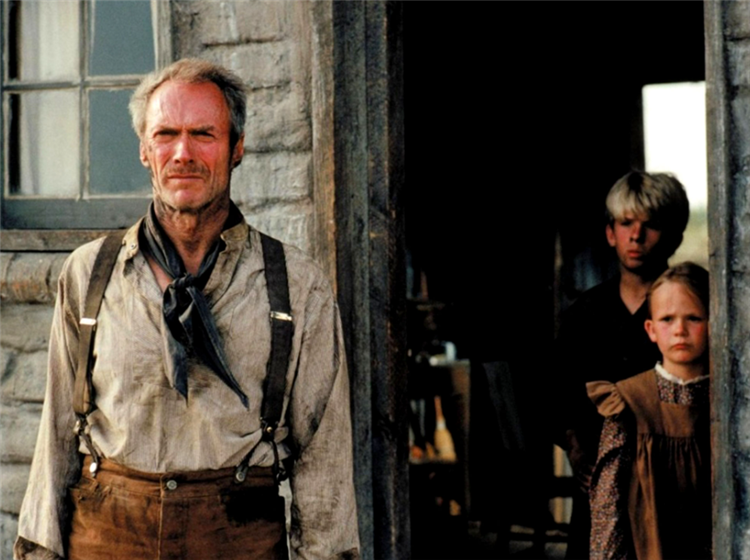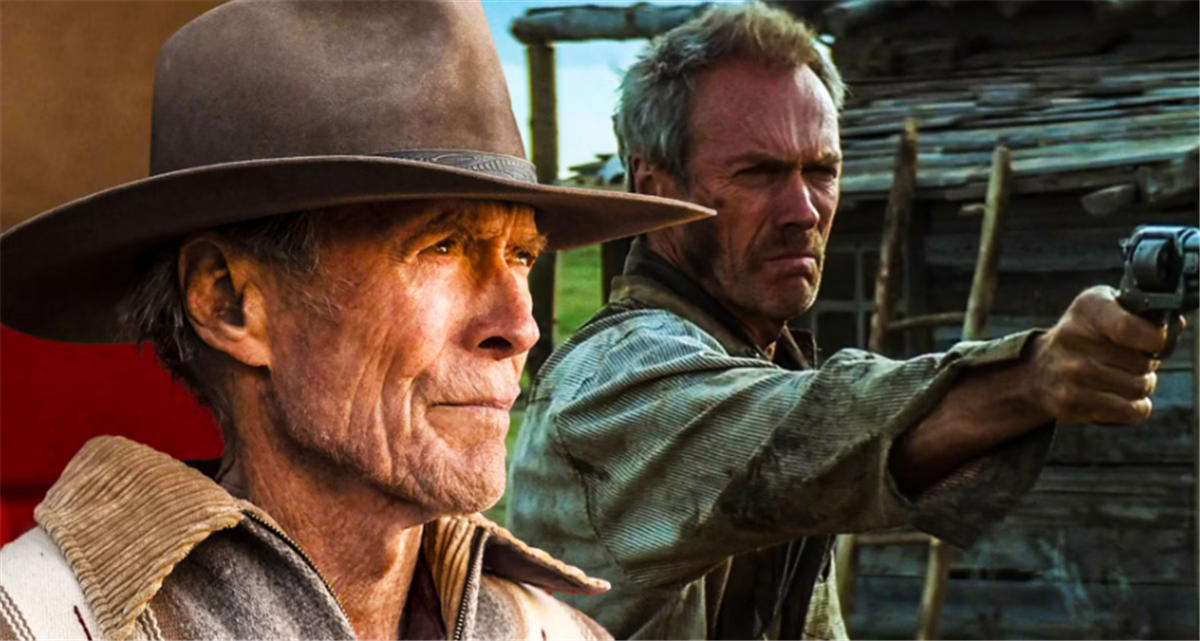There are Revisionist Westerns, and then there are Revisionist Westerns. Unforgiven firmly belongs in the latter category. Barring occasional entries like Dances with Wolves, the early to mid-90s was a period in time when the western genre as a whole was experiencing something of a downward spiral, with waning audience interest and diminished box office returns. And it was in this bleak backdrop back in the year 1992 that Clint Eastwood’s Unforgiven was released.
Before screenwriter David Webb Peoples’ career exploded and his name became associated with such high-profile films like Blade Runner and 12 Monkeys, he was a simple, hardworking unknown in Tinseltown trying to make ends meet. Although Peoples worked primarily involved film editing the chap’s passion was writing, and he kept on churning spec scripts to catch the eye of would-be clients.
Peoples’ first stab at success came when he was hired by Ridley Scott to craft the script of Blade Runner, after lead writer Hampton Fancher and Scott parted ways. Although a box office dud at the time of its release, the sci-fi drama has since been reevaluated and embraced as a masterpiece of its genre, and Peoples was part of its creative process.
Somewhere in 1976 the talented writer completed his script for Unforgiven, then alternatively titled as The William Munny Killings and The Cut-Whore Killings. Needlessly to say, with a grotesque title like that many creatives turned away from it until it caught the attention of none other than Francis Ford Coppola.
The intrepid director had a phenomenal run in the 70s with movies like The Godfather, The Conversation and Apocalypse Now under his belt but the following decade saw things slow down a bit for the gifted auteur. Hence, he was looking for something revitalize things when he came across Peoples’ unproduced script. Coppola saw potential and decided to option the screenplay, but couldn’t get the project off the ground.
When Coppola’s option on the script expired in 1985 Clint Eastwood picked it up, but even he too was initially dissuaded from pursuing the effort by his long-time associate Sonia Chernus, who was appalled after reading the material. In one of her memos to Eastwood, Chernus had this to say about Peoples’ screenplay, “We would have been far better off not to have accepted trash like this piece of inferior work. I can’t think of one good thing to say about it. Except maybe, get rid of it fast.”

Eastwood took her advice to heart and didn’t read the script. However, whilst looking out for potential talents to retool a different project he was involved with, Eastwood inevitably went through it and liked what he read. He liked it so much that he decided he should play the lead, as well as helm it. With this in mind Eastwood pushed back Unforgiven until he was just the right age to personify the main character of the bleak tale.
By the time filming officially kicked off several years had already elapsed and it was August 26, 1991. With a modest budget of $14.4 million and a lean production period of 39 days, shooting wrapped on November 12th the same year, four days ahead of schedule. Eastwood’s economical shooting style was heavily influenced by Don Siegel, the director of 1971’s controversial neo-noir crime drama Dirty Harry. “Don was a guy who could get a lot on film with very little in the way of budget and by watching him I tried to grab that. I don’t shoot quite as lean as Don but I do plan things out,” Eastwood revealed during a behind-the-scenes interview.
Unforgiven was shot entirely on location in a remote ranch section in Alberta, Canada. In keeping with the feel of the period that they were trying to recreate, cast and crew were requested to come to work via horsepower and no motor vehicles were allowed on set. As Eastwood is a stickler for detail and authenticity he hired longtime collaborator Henry Bumstead, a two-time Academy Award winning production designer, to design and build the 1880s town of Big Whiskey, Wyoming from the ground up.
The Unforgiven set wasn’t a façade either, simply there as window dressing. all of the buildings were fully functional – built with extensive interiors and the whole shebang. Since the pre-production period was relatively short, Bumstead only had a narrow window of two months to achieve the impossible. And he achieved it in style and then some, going on to nab an Academy Award nomination for his work during awards season.
Jack N. Green stepped in as DOP for the movie, and like Bumstead he too had worked with Eastwood on many occasions, lensing every film helmed by the Hollywood legend from 1986 to 2000. For Unforgiven Green went for a more somber look, given the nature of the story, which brought to mind cinematographer Gordon Willis’ stunning work on The Godfather franchise. As a result, the scenery featured in Unforgiven was one drenched with mood, atmosphere and foreboding.
The bittersweet, minimalist score meanwhile was conjured by frequent Eastwood collaborator Lennie Niehaus, however, the main theme of the soundtrack was composed by Eastwood himself.
When it came to the casting process Eastwood always had his eye on a handful of performers, who he knew would deliver on the money. He cast Gene Hackman to play the sadistic town Sherriff Bill Daggett, but initially Hackman was concerned about the film’s excessive violence, so much so that he needed reassuring from Eastwood to board the project.
“I swore I would never be involved in a picture with this much violence in it,” said Hackman during a DVD tete-a-tete. “But the more I read it, the more I came to understand the purpose of the film, the more fascinated I became.” Eastwood also advised Hackman to look up former LA Police Chief Daryl Gates, a real-life douchebag in law enforcement, as inspiration for his dastardly character. Suffice to say Eastwood’s advise certainly worked, as Hackman walked away with the Oscar for Best Supporting Actor at the 65th Academy Awards.

Morgan Freeman, whoplays Munny’s best friend Ned Logan, got involved with the film through a very unconventional manner. Freeman learned about the movie that same year, from Kevin Costner while filming Robin Hood: Prince of Thieves and approached Eastwood for a potential role, and that’s how the actor became part of Unforgiven.
For the part of English Bob, Eastwood went for British thespian Richard Harris. Harris had initially thought it was a prank, when Eastwood called him up one evening, whilst he was watching High Plains Drifter on television. Although English Bob’s role in the story is comparatively small, Harris steals every scene he’s in with some trademark British snobbery and wit.
With Unforgiven, Eastwood wanted to completely deconstruct the Western movie genre, subverting the myth and stripping away the romanticized elements often associated with the Old West, in cinema. Eastwood’s extensive work on Sergio Leone’s Spaghetti Westerns in the 60s certainly gave him the much-needed foundation and exposure, to put his personal stamp on the one genre he treasured and loved above all else.
Although Unforgiven is less Leone and more Peckinpah in more ways than one, there’s no denying this was a deeply personal film for Eastwood as an actor, as well as a filmmaker. The unflinchingly brutal Western cemented Eastwood as a creative force to be reckoned with in front of, and behind the camera, and in appreciation of his critically acclaimed work on Unforgiven he was bestowed with the Oscar for Best Director at the 65th Academy Awards.
Unforgiven also garnered the Oscar for Best Picture that same evening, the third Western to do so, following 1931’s Cimmaron and 1990’s Dances with Wolves. Box-office wise the movie concluded its run with a global gross of $159.2 million, which is certainly impressive considering its modest budget and mature subject matter. Regardless, it’s safe to say that Unforgiven has more than earned its place in the cinematic pantheon as one of the greatest Revisionist Westerns of all time, helmed and headlined by its greatest icon.
